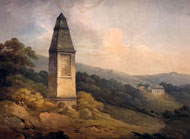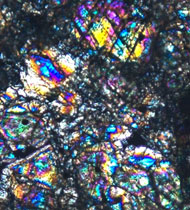Wold Cottage meteorite
The earliest surviving meteorite seen to land in the UK fell in Wold Cottage, Yorkshire, in 1795. It prompted the first serious investigation into the origin of meteorites and helped confirm they came from space.

Wold Cottage landowner Edward Topham erected a monument to mark the meteorite landing site. Painting by George Nicholson, 1812.
Extraordinary landing
On 13 December 1795, ploughman John Shipley looked up from his work on the Wold Cottage estate to see a stone land a few metres away. Sending soil flying, it embedded itself in the chalk rock beneath.
A year earlier, German physicist Ernst Chladni had started recording similar events. He was ridiculed for suggesting the stones fell from space.
The preferred theory was that the stones were blasted into the air by volcanoes. But with no active volcanoes in Yorkshire, how could the Wold Cottage landing be explained?
Extraterrestrial origins

Meteorites illustration by James Sowerby, 1812. The Wold Cottage meteorite is shown in the centre. It weighed 25kg.
Influential scientist Joseph Banks began to doubt the volcano theory. He commissioned a worldwide comparison of stones from the sky.
The results proved Chladni right. The stones were very similar to each other but were like nothing on Earth. They must have had the same origin: space.
There was such public demand to see the Wold meteorite that private museum owner James Sowerby bought it to display.
In 1835, a relative of Sowerby's sold it to the Natural History Museum (part of the British Museum at the time). We now look after one of the most diverse and important collection of meteorites in the world.
Cosmochemistry - understanding the solar system

Cross-polarised light microscope image of a slice of the Wold Cottage meteorite. The different colours show different minerals.
By studying the chemistry of meteorites, our scientists can discover how the different materials they are made from were mixed up during the formation of the solar system. We can find out what happened during the meteorite’s lifetime by slicing it thinner than a human hair and looking at the crystals.
We now know that the Wold Cottage meteorite was a piece of debris sent careering to Earth after 2 asteroids smashed together.
Asteroids were formed from a cloud of dust, gas and ice during the birth of the solar system about 4.6 billion years ago. Most orbit the Sun in the asteroid belt between Jupiter and Mars.
Our scientists are using meteorites to work out when the first solid objects formed, which became the building blocks of the asteroids and planets we see today.
Further information
- Visit the Wold Cottage meteorite in our new Treasures Cadogan Gallery.
- Discover the best places to collect meteorites and how to identify them.
- Find out fascinating facts about meteorites, from how often they fall to how we can tell if a rock is a rare meteorite from Mars.
Vote for your favourite treasure
Is this your favourite Museum treasure? Let us know by voting in our poll.
